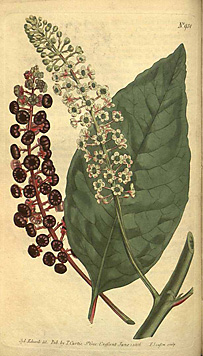Poisonous Pokeweed
By Audrey Stallsmith

Down there we have a plant that grows out in the woods and the fields,
and it looks something like a turnip green.
Everybody calls it Polk salad. . .
Used to know a girl that lived down there and
she'd go out in the evenings to pick a mess of it,
Carry it home and cook it for supper, 'cause that's about all they had to eat,
But they did all right.
"Polk Salad Annie"--Tony Joe White
The above song gives the mistaken impression that polk salad--more correctly known as poke sallet since salad implies uncooked greens--can be eaten at any time of year. Actually it's only edible for a short time in the spring when the plants are under 6" tall.
Even then, persons harvesting the shoots are advised to avoid any that show traces of red and to boil those shoots several times over, discarding the water each time, before eating them. The flavor is supposed to be somewhat similar to asparagus.
The repeated boilings are meant to expel the plant's toxins, which should clue you that poke can be a very dangerous vegetable indeed! Still, settlers who hadn't had fresh greens all winter would probably have found them tasty enough to make the risk worthwhile. Poke berries are also supposed to lose their toxicity after being cooked, but--considering that children have died after eating the raw ones--this is not a theory that I intend to test!
The plant grows fast, and can reach ten feet before it's shriveled by a killing frost. Supporters of James Polk for President pinned poke leaves leaves to their lapels as the first campaign buttons. Since those leaves can be 10 inches long, however, I doubt they made very good boutonnieres! The same punning instinct made poke stand for "poking fun" in the Language of Flowers.
The official name, Phytolacca americana, derives from the Greek phyton ("plant") and the Latin lacca, an insect from which dye was made. Poke berries were, we might say, the New World version of lacca. Native Americans used them as a dye or body paint and the early settlers employed them to make ink. In fact, the Constitution was supposed to have been written in pokeberry! Some less reputable winemakers even used that juice to color their port.
The plant has also been known as pokeweed, inkberry, American nightshade, garget, pigeon berry, bear's grape, cancer root, pocan, and cokan. "Poke" probably came from the Algonquian name "puccoon."
Native Americans used infusions of poke root to treat rheumatism, and applied the herb externally to soothe skin disorders. The Amish still make a salve out of poke berries boiled in lard. The plant was also employed in glandular diseases, to kill scabies infections, and to help "draw out" boils or abscesses.
All of this is risky, since the toxins from poke can be absorbed through the skin. And the plant, in large enough doses, is emetic, purgative, and narcotic. Meaning that it can make you throw up, give you diarrhea, and--if you have absorbed too much of it--might even kill you by paralyzing your respiratory system.
Livestock can also be poisoned by the plant, but don't often eat it unless there's nothing else available. Strangely enough, birds don't seem to be affected, since they seem quite fond of the raw berries which most humans find distasteful. Farmers used to put poke root in the water they gave their poultry, since it was reputed to prevent disease. (Because it contains saponins, it has also been used as a soap substitute.) Those farmers also applied a poke-in-lanolin salve to their cows' swollen udders.
And the herb does show considerable promise in treatment of cancer and AIDS. Here too, however, poke can be equivocal. Although it seems capable of targeting and killing certain cells, it can also multiply those cells, making a cancer or virus worse instead of better. So much further research will probably be required!
In the meantime, it's probably best to admire this staturesque plant from a safe distance. In autumn its leaves can reportedly turn phosphorescent in the dark. So that specter in the graveyard may just be poke, enlarging on its scary reputation!
Poke image is courtesy of the Southwest School of Botanical Medicine.








